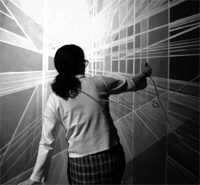Virtual Reality and the Unfolding of Higher Dimensions
January 15th, 2006
Categories: Applications, Visualization, VR Art

Authors
Aguilera, J.About
As virtual / augmented reality evolves, the need for spaces that are responsive to structures independent from three dimensional spatial constraints, become apparent. The visual medium of computer graphics may also challenge these self imposed constraints. If one can get used to how projections affect 3D objects in two dimensions, it may also be possible to compose a situation in which to get used to the variations that occur while moving through higher dimensions. The presented application is an enveloping landscape of concave and convex forms, which are determined by the orientation and displacement of the user in relation to a grid made of tesseracts (cubes in four dimensions). The interface accepts input from tridimensional and four-dimensional transformations, and smoothly displays such interactions in real-time. The motion of the user becomes the graphic element whereas the higher dimensional grid references to his / her position relative to it. The user learns how motion inputs affect the grid, recognizing a correlation between the input and the transformations. Mapping information to complex grids in virtual reality is valuable for engineers, artists and users in general because navigation can be internalized like a dance pattern, and further engage us to maneuver space in order to know and experience.
Keywords: Virtual reality, higher dimensions, tesseract, design, grid
Resources
Citation
Aguilera, J., Virtual Reality and the Unfolding of Higher Dimensions, Proceedings of the IS&T / SPIE’s Electronic Imaging 2006, San Jose, CA, January 15th, 2006.